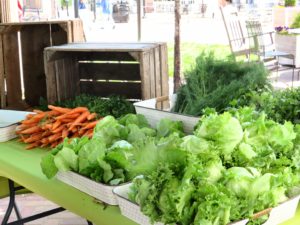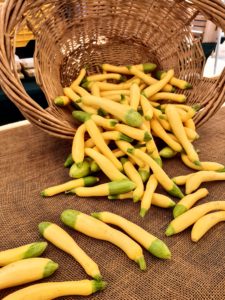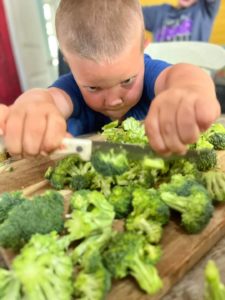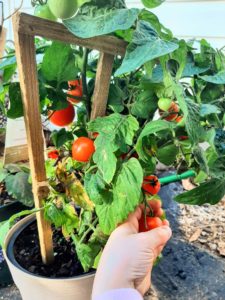by Jessica Frierson, June 2022
 Do your children know where their food comes from? If their answer to that question is the name of a grocery store, then it may be a good time to head to your local farmer’s market or, even better, an area farm. Why is this an important concept for them to understand? Giving a child a better understanding of the source of their food helps them to eat smarter, eat healthier, enjoy the food they eat, and develop an appreciation for what they eat.
Do your children know where their food comes from? If their answer to that question is the name of a grocery store, then it may be a good time to head to your local farmer’s market or, even better, an area farm. Why is this an important concept for them to understand? Giving a child a better understanding of the source of their food helps them to eat smarter, eat healthier, enjoy the food they eat, and develop an appreciation for what they eat.
We gain a greater appreciation for things when we understand their worth. When a child sees a bag of potatoes or a cluster of grapes on their table at home, they cannot begin to comprehend all that went on behind the scenes in order for that to be produced. Seeing fields being prepared for planting, intricate irrigation systems set up to keep the crops watered, and learning about the effort that goes into harvesting crops will help children value their food more.
 This in turn will help our children become more conscious consumers who understand the importance of supporting our local and regional economies. According to Michigan State University Extension office, in 2012 only ten cents out of every dollar that was spent on food made it back to the farmer who grew it. One way we can help our local farmers get a greater return on the investment of their time, cost, and labor is to shop at a farmer’s market as often as possible. Although summer is the season where you can find a greater variety of fresh produce, don’t forget to visit in the off-season as well. Many communities now offer year-round farmers markets that carry seasonal produce, honey, hand-made soaps, fresh baked goods, and farm-raised meat and dairy products. Many farmers markets now accept EBT/SNAP and even double the value of it, further helping out many families.
This in turn will help our children become more conscious consumers who understand the importance of supporting our local and regional economies. According to Michigan State University Extension office, in 2012 only ten cents out of every dollar that was spent on food made it back to the farmer who grew it. One way we can help our local farmers get a greater return on the investment of their time, cost, and labor is to shop at a farmer’s market as often as possible. Although summer is the season where you can find a greater variety of fresh produce, don’t forget to visit in the off-season as well. Many communities now offer year-round farmers markets that carry seasonal produce, honey, hand-made soaps, fresh baked goods, and farm-raised meat and dairy products. Many farmers markets now accept EBT/SNAP and even double the value of it, further helping out many families.
Shopping at the farmer’s market not only helps our local farmers, it also gives our families the chance to eat healthier. The fresher our food is, the healthier it will be. Purchasing directly from the person who grew your food gives you the opportunity to be more informed about it. You can ask what, if any, chemicals were used for pest control or as fertilizers. You can get recipe ideas and cooking suggestions. When I was purchasing a cantaloupe last week from a local vendor, they asked me if I was planning to eat it that day or needed one that would keep a little longer. You may also find varieties of fruits and vegetables that are not available at the supermarket, such as the golden zucchini I also found that day.
The fresher our food is, the healthier it will be. Purchasing directly from the person who grew your food gives you the opportunity to be more informed about it. You can ask what, if any, chemicals were used for pest control or as fertilizers. You can get recipe ideas and cooking suggestions. When I was purchasing a cantaloupe last week from a local vendor, they asked me if I was planning to eat it that day or needed one that would keep a little longer. You may also find varieties of fruits and vegetables that are not available at the supermarket, such as the golden zucchini I also found that day.
Many farmers markets now include far more than just the produce of their fields and orchards. As the advantages of free-range eggs, farm-raised meats, and fresh milk have become more recognized, consumer access to these products has improved. Family farms often welcome visitors to explore their facilities where they can see firsthand the cows grazing in the pastures or their milk parlors. Local butchers are also a good source of fresh meat as well as a great learning experience. Many will be pleased to show you where the various cuts of meat are taken from on the animal and offer advice on how to best cook different types of cuts.
 As you shop with your child, you can discuss what vitamins and minerals your body needs and which foods are good sources of those. When children have a part in selecting their food, they are more likely to eat it. The colorful artistry of a vegetable display may inspire your picky eater to try a food they would normally reject. Knowing that their body needs vitamin A to build a healthy immune system, fight cancerous cells, see better, and prevent acne may make a child more likely to eat some carrots, sweet potatoes, or red peppers. Teach them to “eat a rainbow,” then let them help to plan out a rainbow-inspired menu.
As you shop with your child, you can discuss what vitamins and minerals your body needs and which foods are good sources of those. When children have a part in selecting their food, they are more likely to eat it. The colorful artistry of a vegetable display may inspire your picky eater to try a food they would normally reject. Knowing that their body needs vitamin A to build a healthy immune system, fight cancerous cells, see better, and prevent acne may make a child more likely to eat some carrots, sweet potatoes, or red peppers. Teach them to “eat a rainbow,” then let them help to plan out a rainbow-inspired menu.
Meeting the people who grow the food they eat helps a child to be more connected to their community. They learn to see the interconnectedness of the world around them. Integrating them in the process of choosing and acquiring their food transforms them from a passive consumer into someone who uses critical thinking skills, values relationships, and understands healthy farming means.
I have written before about how much a child can learn from growing their own garden, whether it is a large plot in the backyard or a few containers on your patio. This is another way you can help your child understand where their food comes from. Just starting one tomato plant from seed and watching its growth until they are able to pick a juicy red tomato ready to slice can give them an idea of the hard work and dedication it takes from the farmers of our nation in order for us to enjoy the vast array of food available to us.
backyard or a few containers on your patio. This is another way you can help your child understand where their food comes from. Just starting one tomato plant from seed and watching its growth until they are able to pick a juicy red tomato ready to slice can give them an idea of the hard work and dedication it takes from the farmers of our nation in order for us to enjoy the vast array of food available to us.
Teaching our children to value our food supply and food sources is an important lesson. Like many lessons they learn while homeschooling, it can be very hands-on and enjoyable. So check your local listings for a farmers market, pick-your-own farm, or produce stand near your home and be ready to plan a delicious menu from your purchases!
 Jessica Frierson is a homeschool graduate and has been homeschooling her ten children since 2000. She serves as the secretary for NCHE, writes for GREENHOUSE, and is the lead blogger for the NCHE blog.
Jessica Frierson is a homeschool graduate and has been homeschooling her ten children since 2000. She serves as the secretary for NCHE, writes for GREENHOUSE, and is the lead blogger for the NCHE blog.
The post Teaching Children to Value Their Food appeared first on North Carolinians for Home Education.
